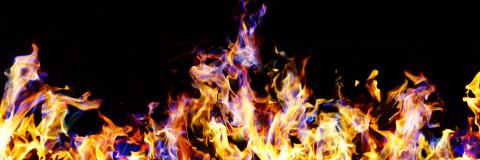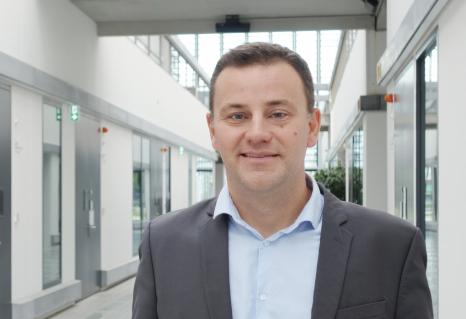
Franck Richecoeur: Fanning the Flame of Engineering Research
Franck Richecoeur is an assistant professor at the Macroscopic Molecular Energy and Combustion Laboratory (EM2C - Université Paris-Saclay, CNRS, CentraleSupélec) and the director of the Engineering and Systems Sciences Graduate School at Université Paris-Saclay. He specialises in micro-combustion, a research field at the crossroads of several engineering science disciplines, in which applied developments enrich basic knowledge.
During his first year at the ISAE ENSMA in Poitiers, Franck Richecoeur’s project was chosen by the European Space Agency (ESA) to take part in an event bringing together young scientists in Mérignac in July 2001. After months of development, with the support of researchers and technicians from the Combustion Laboratory (known today as Pprime) in Poitiers, the student carried out his first two parabolic flights with around sixty teams from around the world, and presented the results of his experiments the following year in Japan. “It was an extraordinary experience as a human as well as a scientist,” remembers Franck Richecoeur. “This was the first time I had been involved in research with a real experimental theme.”
At the end of his second year in engineering school, he set sail for a laboratory at Yale University to spend four months as a visiting scholar. “Micro-combustion consists of atomising fuel as quickly as possible to burn it in a very small volume (1 cm3), while also capturing the heat”, explains the researcher. At the age of 22, Franck Richecoeur set up two new experiments, the results of which contributed to Yale University’s Professor Alessandro Gomez’s research. “We looked at how to improve combustion efficiency in our tiny, low energy but very compact burners.” Upon his return to France, he graduated from the ISAE while also getting a Master's degree from the Université de Poitiers. During his final year Master’s internship at another American laboratory (Illinois), Franck Richecoeur published his first major paper. In the autumn of 2013, he contacted Sébastien Candel, a researcher at the EM2C laboratory, to start his PhD. His work, funded by the French National Centre for Space Studies (CNES), focused on combustion instability in rocket engines. “Flames can be quite calm, such as on a gas hob in a kitchen, for example, but they are a lot more vigorous in a car, aeroplane or rocket engine,” he explains. “They can oscillate so much as to make vibrate, and break, the engine. Indeed, this is the reason why the Ariane rocket failed in the 80’s.”
Listen to the sound of the flame
Franck Richecoeur has been lucky enough to work on one of the world’s four cryogenic test benches at ONERA. This test bench is used to burn oxygen and hydrogen at a low temperature. The team was the first to be able to observe flames that could either intensify or weaken high-amplitude acoustic oscillations that were sent into them. The young researcher was able to take advantage of new signal processing techniques and the computational power of computers to process measurements in real time to develop a digital simulation that reproduced the images of the few seconds of the experiment. After defending his thesis in 2006, and completing a short post-doc at the CNES, he was hired by the EM2C laboratory as an associate professor.
Multidisciplinary engineering research
The researcher is revisiting combustion instability in light of new scientific tools stemming from different fields. Thanks to the research by mathematicians, he has been able to develop new descriptive models about the temporal evolution of pressure, which made it possible to identify the thresholds beyond which the oscillation would cause the structure to explode. “I carry out applied research involving multiphysics issues,” he asserts. “We begin with one discipline and go on to learn about others such as chemistry, which describes the reaction mechanisms inside flames, fluid mechanics, which controls flows, acoustics, which couples walls and flames, and heat science, which explores thermal radiation and interactions. Lastly, combustion perfectly demonstrates what engineering research is. The real difficulty is putting these disciplines together into one complex system.”
A virtuous circle
The researcher works with companies, not so much for immediate application as to create multi-disciplinary methods for their engineers to solve problems. He therefore participates in the better understanding of discipline fundamentals. “Combustion is a very good systemic example,” says Franck Richecoeur. “When an engineer attempts to calculate the size of a combustion chamber in a turbojet engine at Safran, for example, they cannot simply take a fluid mechanics code and put it together with a chemistry code. This cannot work unless specific tools have been previously developed by researchers.”
Several multiphysics models have been developed for the aerospace and energy industries. However, in the past decade or so, research into combustion has transformed in light of its environmental impact. The current challenge is to understand fuel-related pollution and noise, and to address specific needs in a very targeted way. “We are looking at how fuel behaves when it shifts from a state of continuous fluid to tiny droplets that ignite,” explains the researcher. “The characteristics of this spray are different when made with biofuels or kerosene, but it remains a source of pollution that is very difficult to control.”
Uniting engineering
Since his arrival at École Centrale in 2007, Franck Richecoeur has been involved in providing methodological support for student projects and in creating skills modules: listening, reformulating a problem, developing a hypothesis, implementing a scientific approach, etc. With the encouragement of the École’s leadership, the researcher quickly took on academic responsibilities. The merger with Supélec was an occasion to work with people from different cultures and disciplines. Franck Richecoeur’s appointment to the head of the Engineering and Systems Sciences Graduate School at Université Paris-Saclay represents a desire to unite Engineering. By bringing together Université Paris-Saclay’s whole engineering science ecosystem (60 laboratories, 2,500 researchers, 1,200 Master’s students and 700 doctoral students), it has become a cornerstone for the Université. “The challenge is to increase understanding of what research and education in engineering science are today. We would like to show that there are several types of engineering science education, in particular with Master’s degrees at the Graduate School », asserts Franck Richecoeur. In July 2021, this message was passed onto around 50 young people in their first year of the French baccalaureate (A level) during the first Summer Camp. They were selected among all high schools in France, and spent a week at CentraleSupélec in complete immersion. “We have been able to develop new networks with very committed high schools”, Franck Richecoeur is pleased to say.

